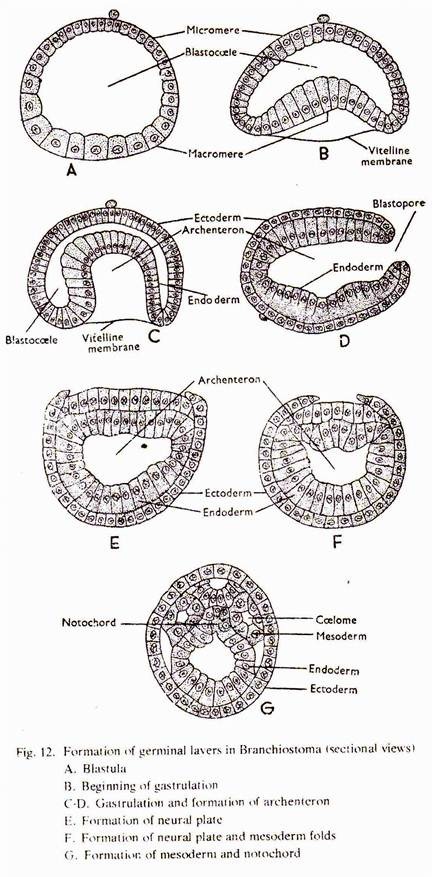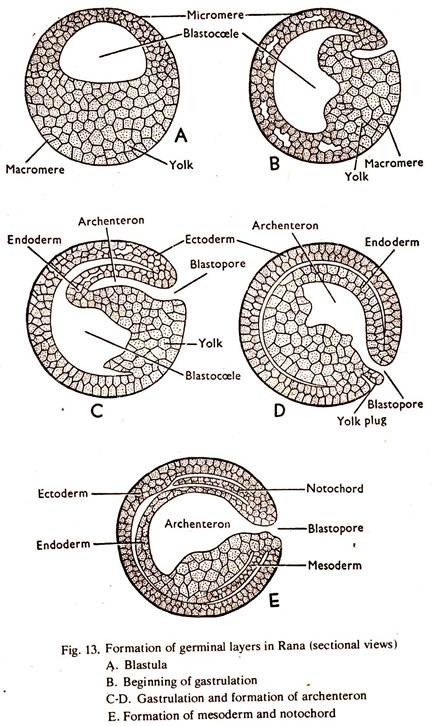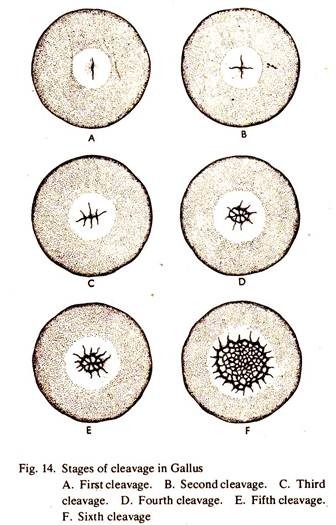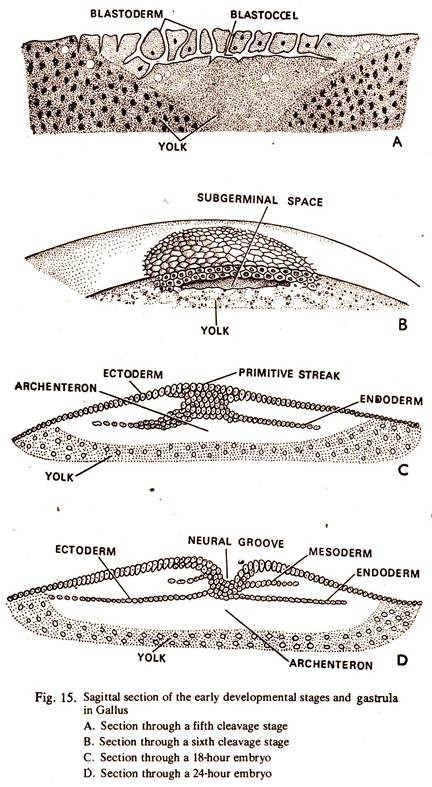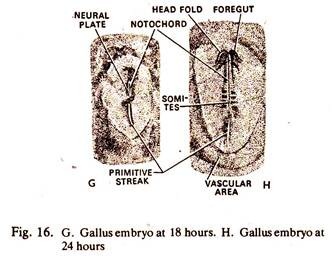Learn about the comparison of formation of germinal layers in various vertebrates.
Comparison: Vertebrate # Branchiostoma:
1. The egg is teleolecithal, i.e. provided with a little yolk and covered by two thin membranes, the outer vitelline and the inner perivitelline membrane. Impregnation is external.
2. Segementation – Segmentation is holoblastic but slightly unequal. The first cleavage takes palce along the meridional line, the second is also meridional but at right angle to the first; the third is latitudinal. Further divisions take place and a blastula enclosing a large blastocoel or primary body cavity filled with a fluid is formed. The cells of the lower or vegetal pole are larger than the rest.
3. Gastrula – The single-layered blastula is transformed into a two layered gastrula enclsing an archenteron, by a process known as gastrulation. Gastrulation takes place by invagination, involution and a kind of epiboly. The rapid divisions of the micromeres lead to the invagination of the blastula.
ADVERTISEMENTS:
Gradually, a two layered embryo is formed and the blastocoel is completely obliterated. The gastrula is now like a basin. It gradually bends, the archenteron is formed, and the blastopore destined to form the anus becomes narrower. The dorsal surface of the embryo is flattened, the ventral surface convex and the blastopore is posterodorsal. Cilia develop from the ectoderm. Now the outer cell layer is known as ectoderm and the inner layer, the endoderm.
4. The ectoderm of the median portion sinks below and form the medullary plate. The medullary folds gradually cover the plate, which forms the neural tube. The endoderm cells lining the archenteron develop a pair of dorsolateral longitudinal folds. Transverse folds appear and divide the longitudinal folds into a series of coelomic pouches and this is the beginning of the formation of mesoderm.
Gradually the endoderm cells which become cut off from the cells lining the archenteron give rise to the definitive mesoderm and the endoderm cells which are now drawn to line archenteron completely, form the definitive endoderm.
Comparison: Vertebrate # Rana:
1. The egg is telolecithal with an upwardly directed; pigmented protoplasmic mass and a lower white portion loaded with yolk. It is surrounded by a sphere of jelly. Impregnation is external.
ADVERTISEMENTS:
2. Segmentation – Segmentation is holoblastic but slightly unequal. The first cleaveage takes place along the meridional line, the second is also meridional but at right angle to the first, the third is latidutinal and four small black and four large white cells are formed. Furhter divisions take place and a blastula enclosing a small blastocoel is formed. The divisions of he upper pigmented cells are rapid than the lower yolk cells.
3. Gastrula – The blastula is transformed into a gastrula enclosing an archenteron by a process known as gastrulation. Gastrulation takes place by epiboly, involution, invagination and convergence. The pigmented cells grow down over the yolk cells produced from the yolk-cells acquire pigment, develop the character of ectoderm and gradually extend.
The whole embryo is now covered by ectoderm cells except a small patch known as yolk plug. The margin of the ectoderm layer surrounding the yolk-plug represents the lip of the blastopore. The whole phenomenon is epiboly. A splitting takes place among the yolk-cells, beginning at the edge of the blastopore and gradually extends forward.
The process is aided by invagination of the small cells of the upper hemisphere (ectoderm) and the archenteron is formed. Archenteron does not communicate with the exterior for a long time, the blastopore being closed by the yolk-plug. The archenteron extends forward and the blastocoel disappears. The yolk-cells surrounding the archenteron become differentiated and form the definitive endoderm.
ADVERTISEMENTS:
4. The endoderm cells surrounding the archenteron undergo splitting and the mesoderm cells appear. These form several layers deep surrounding the archenteron. Mesoderm exists throughout the greater part of the embryo between the ectoderm and the endoderm.
Comparison: Vertebrate # Gallus:
1. The egg is large and telolecithal. The germinal disc is situated on the upper surface of the heavy yolk-mass. Impregnation is internal. The completed egg receives a two-layered coating or shell membrance and finally a calcareous shell.
2. Segmentation – Prior to laying, segmentation starts. It is meroblastic and discoidal. The first cleavage is vertical and does not reach the edge of the germinal disc. The second one is also vertical but at right angle to the first. After several cleavages a single layer of cells is produced.
Now a horizontal cleavage takes place and the cells are separated from the yolk, except the border of the germinal disc. A cavity, the blastocoeol or sub-germinal cavity appears between the cells and the yolk. The egg is now known as blastula and the cellular region, the blastoderm.
3. The blastula is transformed into a two-layered gastrula enclosing an archenteron, by a process known as gastrulation. Gastrulation takes place by invagination and delamination. In invagination, the cells move from the surface layer and detach within the subgerminal cavity, and finally arranged themselves to form a continuous layer.
The original layer is termed ectoderm and the new layer, endoderm. In delamination, scattered cells are separated off the under surface of the blastoderm and being arranged in a row help in the formation of the endoderm. The blastocoel which becomes enclosed by the endoderm layer above and the yolk below is the archenteron.
4. The blastoderm is now distinguishable into a central clearer area, the are pellucida which overlies the subgerminal cavity, and a surrounding opaque area, the area opaca which is placed, directly on the yolk. By the thickening of the ectoderm cells, at the point where the two layers are continuous, the primitive streak appears.
The primitive streak has a central groove and the groove runs along the centre of the area pellucida. From either side of the primitive streak a layer of cells is produced between the ectoderm and the endoderm. This is the mesoderm. All the three cell layers are connected at the side of the primitive streak.
Comparison: Vertebrate # Oryctolagus:
1. The egg is small and isolecithal. Impregnation takes palce while the ova are still in the fallopian tube. Development starts while the zygote comes down to the uterus, and rest of the embryonic period is spent in the uterus.
ADVERTISEMENTS:
2. Segmentation – Segmentation is holoblastic but irregular. The blastomeres produced are approximately of equal size and a spherical mass of cells or morula is formed. Vacuoles appear in one side of the morual and a fluid begisn to accumulate within it. The morula becomes a blastocyst, corresponding to the blastula of lower forms.
The blastocyst consists of an outer cell layer, the trophoblast, and attached to it is a group of cells, the inner cell mass. The cavity of the blastocyst is blastocoel or subgerminal cavity. From the inner cell mass arise the embryonic ectoderm and the entire endoderm. The trophoblastic ectoderm is extra embryonic, because it is concerned with the nourishment of the embryo.
3. The blastocyst is transformed into a two-layered gastrula enclosing an archenteron, by a process known as gastrulation. Gastrulation takes place by delamination and infiltration of cells. The cells are produced by delamination and infiltration from the inner cell-mass on the ventral side and arrange themselves in a single row.
This is the endoderm layer. The rest of the cells of the inner cell mass give rise to the embryonic ectoderm which is situated outside the endoderm. The cavity enclosed by the endoderm is the archenteron. The ectoderm and endoderm are in contact at one point only.
4. At the point where the ectoderm and endoderm are in contact, the primitive streak appears by the thickening of the ectoderm cells. From either side of the primitive streak, cells are produced rapidly and they arrange themselves in a single layer, the mesoderm, in between the ectoderm and the endoderm.
The mesoderm soon splits into two, the outer layer is known as somatic mesoderm; the inner layer, splanchnic mesoderm and the space between the two is the coelom.
